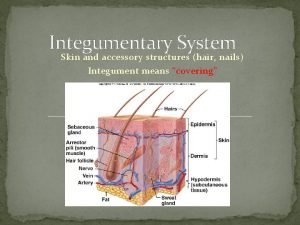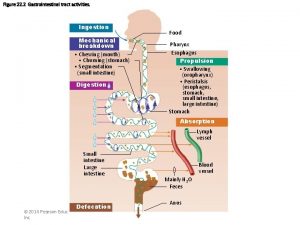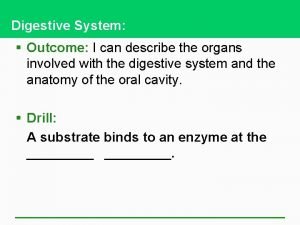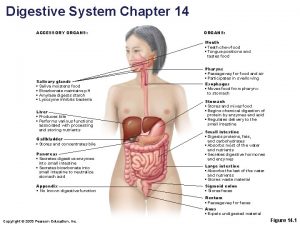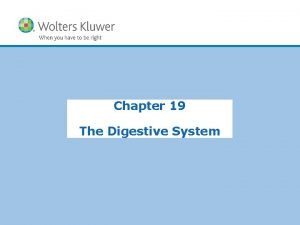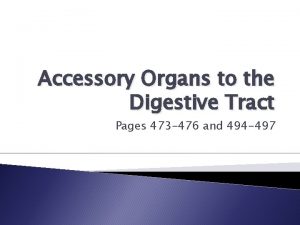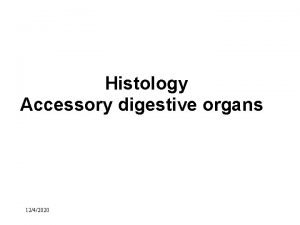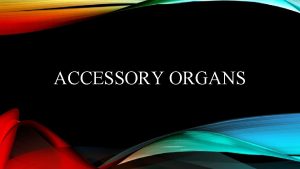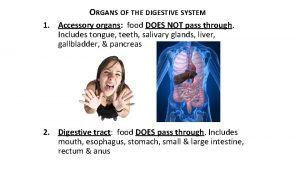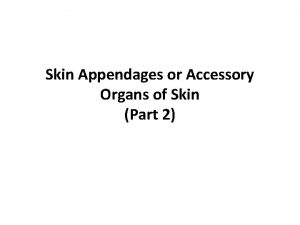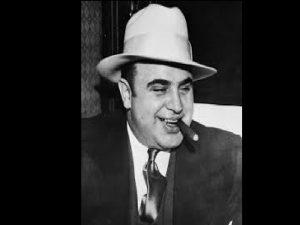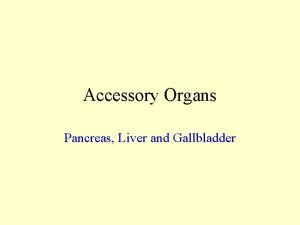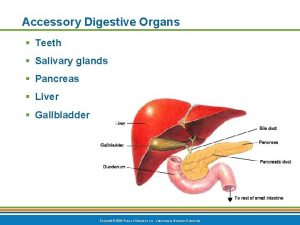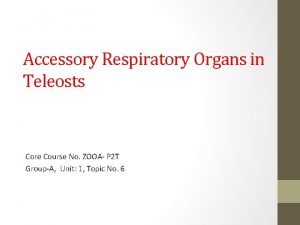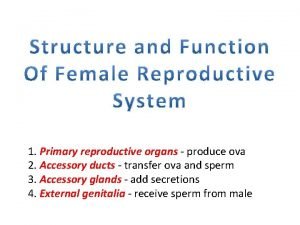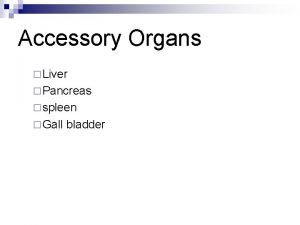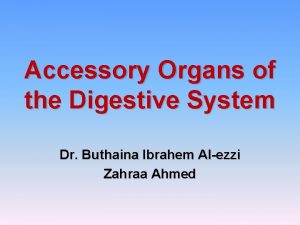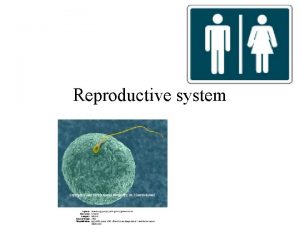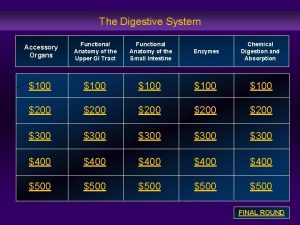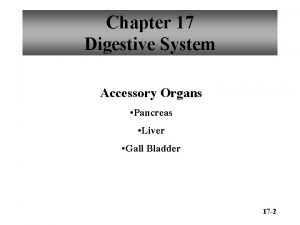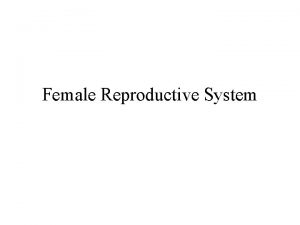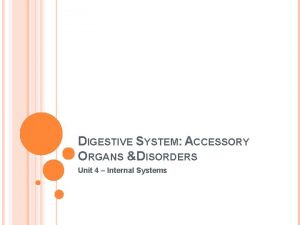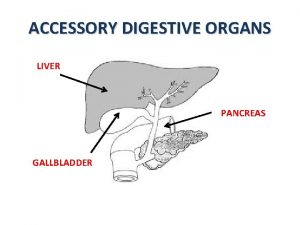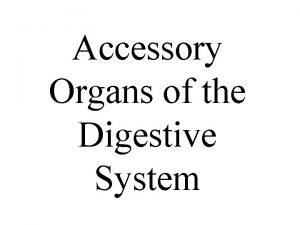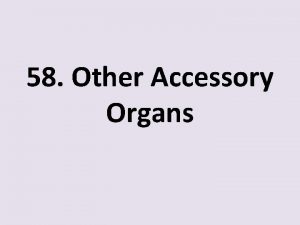Accessory Organs Accessory Organs Not part of the




























- Slides: 28

Accessory Organs

Accessory Organs §Not part of the digestive tract §BUT they are necessary.

LIVER §First organ to receive blood after digestion.


LIVER § Functions: (6) § 1. Produces and secretes bile (Stored in the gall bladder)

LIVER § 2. Breakdown blood cells and hemoglobin.

LIVER § 3. Produces uria from nitrogen breakdown.

LIVER § 4. Makes many proteins and enzymes.

LIVER § 5. Removes poison from blood. (Filtering system).

LIVER § 6. Glucose homeostasis – maintaining blood sugar level.

DISORDERS § Jaundice: Yellow skin § Yellow eyes § Cuticles are yellow § Liver isn’t functioning

§ Bilirubin is a byproduct of the normal breakdown of red blood cells. The liver processes bilirubin so that it can be excreted by the body as waste. At birth, a baby's liver is still developing its ability to process bilirubin. Therefore, bilirubin levels are a little high at birth and jaundice is present to some degree in almost all newborns. This form of jaundice usually appears between day 2 and 5 and clears by 2 weeks. It usually causes no problems.

PHOTOTHERAPY


DISORDERS §Gallstones: Small deposits of fat §Hard, not a problem until duct is blocked


§ Bile contains water, cholesterol, fats, bile salts, proteins, and bilirubin. Bile salts break up fat, and bilirubin gives bile and stool a yellowish color. If the liquid bile contains too much cholesterol, bile salts, or bilirubin, under certain conditions it can harden into stones.



§ Can your diet influence gallstones? § YES § Other causes: § Obesity, estrogen, ethnicity, gender, age, diabetes, fasting, rapid weight loss… All of which increase cholesterol levels in bile.

Disorders § Hepatitis: Inflammation of liver caused by viruses and/or bacteria. Six recognized types (A, B, C, D, E, G.

§ Hepatitis A: transmitted by contaminated food/water § Hepatitis B: transmitted by blood, needles, sexual relations (body fluids) § Hepatitis C: (cause found in 1989) Sexually transmitted, when chronic very dangerous.


Hepatitis B

Hepatitis B This woman is not pregnant. She has hepatitis B and is suffering from liver cancer. Photo taken in a Thailand refugee camp. This woman was a Cambodian refugee. She died four months after she arrived in the camp (average life expectancy after diagnosis of liver cancer is four months. )

Disorders §Cirrhosis: Tissue in the liver is replaced with fat or scar tissue caused by alcohol.


Clubbing results from chronic low bloodoxygen levels. The tips of the fingers enlarge and the nails become extremely curved from front to back.
 Integumentary accessory organs
Integumentary accessory organs Gastric pit
Gastric pit Internal organs
Internal organs Function of the organs in the digestive system
Function of the organs in the digestive system Accessory organs of the digestive system
Accessory organs of the digestive system Major and accessory organs of the digestive system
Major and accessory organs of the digestive system Sinusoids
Sinusoids Vocab level d unit 3
Vocab level d unit 3 Hát kết hợp bộ gõ cơ thể
Hát kết hợp bộ gõ cơ thể Bổ thể
Bổ thể Tỉ lệ cơ thể trẻ em
Tỉ lệ cơ thể trẻ em Chó sói
Chó sói Tư thế worm breton
Tư thế worm breton Chúa sống lại
Chúa sống lại Các môn thể thao bắt đầu bằng tiếng bóng
Các môn thể thao bắt đầu bằng tiếng bóng Thế nào là hệ số cao nhất
Thế nào là hệ số cao nhất Các châu lục và đại dương trên thế giới
Các châu lục và đại dương trên thế giới Cong thức tính động năng
Cong thức tính động năng Trời xanh đây là của chúng ta thể thơ
Trời xanh đây là của chúng ta thể thơ Mật thư anh em như thể tay chân
Mật thư anh em như thể tay chân Phép trừ bù
Phép trừ bù Phản ứng thế ankan
Phản ứng thế ankan Các châu lục và đại dương trên thế giới
Các châu lục và đại dương trên thế giới Thơ thất ngôn tứ tuyệt đường luật
Thơ thất ngôn tứ tuyệt đường luật Quá trình desamine hóa có thể tạo ra
Quá trình desamine hóa có thể tạo ra Một số thể thơ truyền thống
Một số thể thơ truyền thống Cái miệng nó xinh thế
Cái miệng nó xinh thế Vẽ hình chiếu vuông góc của vật thể sau
Vẽ hình chiếu vuông góc của vật thể sau
